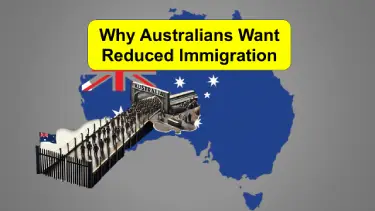Description: Australians Want Reduced Immigration
Australians want reduced immigration. Explore the reasons behind this shift, the validity of these concerns, and the broader implications.
Introduction
In recent years, a growing number of Australians have expressed concerns about the country’s immigration levels, calling for a reduction in the number of new arrivals. This shift in sentiment raises questions about the underlying reasons driving these beliefs.
As Australia grapples with economic uncertainty, housing affordability crises, and environmental challenges, immigration has become a focal point of debate. Many believe that reducing immigration is a necessary step to protect jobs, preserve cultural identity, and ensure sustainable growth. But are these concerns valid, or are they driven by misconceptions?
This article delves into the reasons why many Australians want reduced immigration. We examines the validity of these concerns, and explores what is causing this shift in public opinion. By understanding the complexities behind this issue, readers will gain a deeper insight into the future of immigration policy in Australia.
1. Historical Context
Australia’s Immigration Policy: A Brief History
Australia has long been a nation shaped by immigration. From the post-war boom that brought waves of European migrants to the multicultural policies of the 1970s and beyond, immigration has played a crucial role in the country’s economic and social development. Historically, Australia has welcomed immigrants to address labor shortages, boost the economy, and enhance cultural diversity.
However, immigration policies have evolved over time, reflecting changing economic conditions and public attitudes. The post-war immigration drive, known as the “populate or perish” policy, aimed to increase the population for economic and defense reasons. In the late 20th century, policies shifted to prioritize skilled migrants, reflecting the needs of a growing knowledge-based economy.
Today, Australia’s immigration policy is more selective, focusing on skilled migrants, family reunification, and humanitarian needs. Despite these shifts, immigration remains a cornerstone of Australia’s national identity and economic strategy. Yet, recent years have seen a growing chorus of voices advocating for reduced immigration, signaling a significant change in public sentiment.
2. Current Sentiment: Why Australians Believe Reducing Immigration is Important
Economic Concerns
Job Competition
One of the most commonly cited reasons for reducing immigration is the belief that immigrants take jobs away from Australians. In a competitive job market, especially during economic downturns, this perception is heightened. Many Australians feel that the influx of skilled and unskilled migrants puts downward pressure on wages and increases job competition, particularly in industries like construction, hospitality, and retail.
Housing Affordability
 Housing affordability has become a critical issue in Australia, with soaring property prices making it increasingly difficult for many Australians to buy a home. Some believe that high levels of immigration exacerbate this problem by increasing demand for housing, thereby driving up prices and rents. The idea that reducing immigration could ease the housing crisis is gaining traction among those struggling to enter the property market.
Housing affordability has become a critical issue in Australia, with soaring property prices making it increasingly difficult for many Australians to buy a home. Some believe that high levels of immigration exacerbate this problem by increasing demand for housing, thereby driving up prices and rents. The idea that reducing immigration could ease the housing crisis is gaining traction among those struggling to enter the property market.
Strain on Public Services
Another concern is the perceived strain that immigration places on public services such as healthcare, education, and welfare. It’s important to distinguish between the different levels of government when discussing this issue:
– Federal Level: The Australian federal government does not rely on tax revenue to fund its spending. As the sovereign issuer of the Australian dollar, the federal government can finance its expenditures independently of tax collections. This means that while immigration may increase demand for federal services, such as social security and Medicare, it does not constrain the government’s ability to provide these services. In fact, immigration can contribute to economic growth, increasing the overall resources available for federal programs.
– State and Local Levels: In contrast, state and local governments in Australia do rely on tax revenue, such as GST distributions, property taxes, and other levies, to fund services like public hospitals, schools, and infrastructure. An influx of immigrants can increase demand for these services, which may strain state and local budgets if funding does not keep pace with population growth. Therefore, the concern about public services is more pertinent at these levels of government.
Cultural Concerns
Fear of Losing National Identity
Australia’s cultural landscape has been significantly shaped by immigration. However, some Australians fear that continued high levels of immigration could lead to a loss of national identity. This concern is particularly pronounced among those who feel that Australia’s values and way of life are being diluted by the influence of other cultures. The fear of losing a cohesive national identity has become a rallying cry for those advocating for reduced immigration.
Social Cohesion
Social cohesion is another concern for those who support reducing immigration. They argue that high levels of immigration, particularly from countries with different cultural and religious backgrounds, can lead to social fragmentation. This perception is often fueled by media reports of cultural clashes or instances of communities failing to integrate fully into Australian society. As a result, some believe that reducing immigration would help maintain social harmony.
Environmental Concerns
Impact on Infrastructure
Australia’s infrastructure is under significant pressure due to population growth, much of which is driven by immigration. Traffic congestion, overcrowded public transport, and urban sprawl are common complaints in major cities like Sydney and Melbourne. Some Australians believe that reducing immigration would alleviate these issues by slowing the rate of population growth and allowing time for infrastructure to catch up.
Environmental Sustainability
Environmental sustainability is another factor driving the push to reduce immigration. Australia’s unique environment is vulnerable to the impacts of population growth, such as increased resource consumption, waste production, and habitat destruction. Environmentalists argue that reducing immigration is essential to protecting Australia’s natural resources and ensuring a sustainable future.
3. Examining the Validity of These Concerns
Economic Analysis
Impact on the Job Market
While concerns about job competition are common, research shows that the relationship between immigration and unemployment is complex. Studies indicate that immigrants often fill labor shortages in industries where there are not enough Australian workers, such as healthcare and agriculture. Additionally, immigrants contribute to economic growth by starting businesses, creating jobs, and increasing demand for goods and services. Therefore, the idea that immigrants are taking jobs from Australians may be overstated.
Correlation Between Immigration and Housing Prices
The relationship between immigration and housing prices is also complex. While it is true that immigration contributes to population growth, which can increase demand for housing, other factors such as interest rates, land availability, and housing policies play a more significant role in driving property prices. Reducing immigration alone is unlikely to solve the housing affordability crisis without addressing these underlying issues.
Strain on Public Services
Concerns about the strain on public services are valid, but they need to be viewed within the proper context.
– Federal Services: At the federal level, increased immigration does not directly lead to a lack of resources for services. As the federal government is the currency issuer, it can fund services like healthcare and social security regardless of the tax revenue collected. Immigration can actually bolster these services by contributing to economic growth and expanding the tax base, which enhances the overall fiscal capacity of the nation.
– State and Local Services: On the other hand, state and local governments, which do rely on taxes to fund public services, may face challenges in keeping up with the increased demand brought on by higher immigration. This is especially true if immigration growth outpaces the rate of funding increases. Therefore, while immigration can contribute positively to the economy, it is crucial that state and local governments receive adequate support to expand their services in line with population growth.
Cultural and Social Considerations
Cultural Integration and National Identity
Fears of losing national identity and social cohesion are often based on the assumption that immigrants do not integrate into Australian society. However, research shows that most immigrants do integrate successfully, contributing to Australia’s multicultural fabric. Moreover, Australia’s identity has always been dynamic, shaped by waves of immigration that have enriched the nation culturally and economically. The challenge is not to reduce immigration but to promote policies that support integration and social cohesion.
Social Cohesion in High-Immigration Areas
Case studies from high-immigration areas, such as certain suburbs in Sydney and Melbourne, demonstrate that social cohesion can be maintained with the right policies in place. These areas often benefit from vibrant, diverse communities where different cultures coexist peacefully. However, it is essential to address any tensions that arise by promoting dialogue and understanding between different cultural groups.
Environmental and Infrastructure Implications
Population Growth and Environmental Impact
The environmental concerns associated with immigration are valid, but they need to be balanced against the economic benefits that immigration brings. Reducing immigration alone is unlikely to solve Australia’s environmental challenges. Instead, a holistic approach is needed, one that includes sustainable development, investment in green technologies, and careful planning of urban growth.
Infrastructure Planning and Investment
Infrastructure planning is critical to addressing the challenges posed by population growth. While reducing immigration might alleviate some pressure in the short term, the long-term solution lies in better infrastructure planning and investment. Governments need to ensure that infrastructure keeps pace with population growth to maintain quality of life for all Australians.
4. What is Driving This Sentiment?
Economic Uncertainty
Economic uncertainty is a significant driver of the growing sentiment to reduce immigration. During times of economic downturn, people often become more protective of jobs and resources, leading to a backlash against immigration. The COVID-19 pandemic, for example, has heightened concerns about job security and economic stability, making immigration a more contentious issue.
Political Influence

Political rhetoric and media coverage also play a crucial role in shaping public perceptions of immigration. Populist politicians and media outlets often use immigration as a scapegoat for economic and social problems, amplifying fears and stoking divisions. This has led to a more polarized debate on immigration, with some Australians feeling that reducing immigration is the only way to address their concerns.
Global Trends
Australia is not alone in experiencing a backlash against immigration. Similar sentiments have emerged in other countries, driven by global migration patterns, economic challenges, and political movements. The rise of populism and nationalism in Europe and the United States has had a ripple effect, influencing public opinion in Australia and contributing to the growing call for reduced immigration.
5. The Broader Implications of Reducing Immigration
Economic Impact
Reducing immigration could have significant economic implications for Australia. Immigration has historically been a driver of economic growth, providing a steady supply of workers, consumers, and entrepreneurs. A reduction in immigration could lead to labor shortages, slower economic growth, and reduced innovation. It could also exacerbate the challenges of an aging population, with fewer young people entering the workforce to support the growing number of retirees.
Social and Cultural Impact
The social and cultural impact of reducing immigration could be profound. Australia’s identity as a multicultural nation could be at risk, leading to a more insular and less diverse society. There is also the potential for increased xenophobia and social division as the debate over immigration becomes more polarized. On the other hand, a more measured approach to immigration, with a focus on integration and social cohesion, could help address some of these concerns.
Policy Considerations
To address the concerns driving the push to reduce immigration, policymakers need to strike a balance between maintaining economic growth and ensuring social harmony. This could involve reforms to immigration policy that prioritize skilled migrants, better planning for population growth, and increased investment in infrastructure. At the same time, efforts to promote social cohesion and cultural integration should be strengthened to ensure that immigration continues to benefit Australia.
Conclusion
The growing sentiment to reduce immigration in Australia is driven by a complex mix of economic, cultural, and environmental concerns. While some of these concerns are valid, they are often based on misconceptions or oversimplifications. Reducing immigration alone is unlikely to solve the challenges facing Australia. Instead, a more balanced approach is needed, one that addresses the root causes of these concerns while recognizing the significant contributions that immigrants make to Australian society.
Call to Action
What are your thoughts on Australia’s immigration policy? Should we reduce immigration, or is there a better solution? Share your opinions in the comments below and join the conversation on social media. Don’t forget to subscribe to our newsletter for more in-depth analyses of Australia’s most pressing social issues.
Social Sharing
If you found this article insightful, please share it widely on social media to spread the word.

